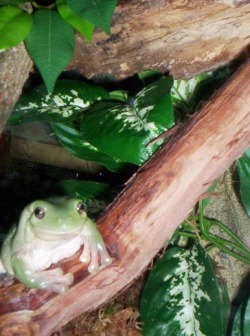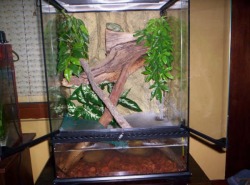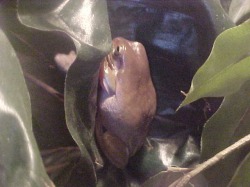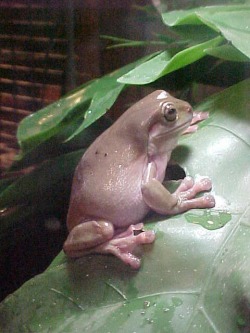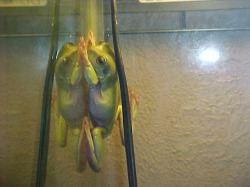Loading
WHITES/DUMPY TREE FROG CARE
Litoria caerulea
REPTILE PLANET web ring
HOUSING
Predominantly arborial, as their name suggest, these frogs do well in a taller terrarium with branches, frolige, real or artificial and hiding places for daytime rest, such as hollowed logs. They are nocturnal and more active from dusk onwards. Substrate is a matter of preferance however, there are few points to keep in mind. Frogs are "gobble feeders", they may accidently ingest loose substrate if eating from it, though they tend to remove inedible or distastful matter with their hands, I dont take the risk. I use aquarium gravel (submerged) and large smooth rocks as land area. I find that apart from sitting in the shallow water to hydrate and catching the stray insect, they spend little time on the floor.
WATER
Frogs dont drink, rather they absorb water through their permiable skin. They require fresh clean water at all times. They also require rather high humidity, around 70% relative humidity [summer only]. A large resevoir of water, enough to hold a filter and for the occasional "swim" serves best for ease of cleaning and maintainance. Moving water created by the flow of a submersible filter creates
consistant humidity, without the need for constant misting of substrates like moss. A chemical filter such as aquarium carbon greatly aids the filtration of invisible waste from the water. My terrarium holds 27liters of water ( 3 standard buckets ) and I change the lot each week and Feces are removed as soon as seen, using an aquarium net.
NOTE: frogs are very sensitive to chemicals including chlorine, thereforE do not use water straight from the tap. I keep a bucket sitting open for a week between changes. This allows chlorine to evaporate from it, beforE use. Do not fill your bucket from the hot tap! Hot water running through copper pipes introduces copper traces to the water which remain, these are harmful.
Beware, small frogs may drown if no purchase can be found from the water, particularly in corners.
My terrarium houses a semi mature pair 8cm sv length.
REPTILE PLANET web ring
HOUSING
Predominantly arborial, as their name suggest, these frogs do well in a taller terrarium with branches, frolige, real or artificial and hiding places for daytime rest, such as hollowed logs. They are nocturnal and more active from dusk onwards. Substrate is a matter of preferance however, there are few points to keep in mind. Frogs are "gobble feeders", they may accidently ingest loose substrate if eating from it, though they tend to remove inedible or distastful matter with their hands, I dont take the risk. I use aquarium gravel (submerged) and large smooth rocks as land area. I find that apart from sitting in the shallow water to hydrate and catching the stray insect, they spend little time on the floor.
WATER
Frogs dont drink, rather they absorb water through their permiable skin. They require fresh clean water at all times. They also require rather high humidity, around 70% relative humidity [summer only]. A large resevoir of water, enough to hold a filter and for the occasional "swim" serves best for ease of cleaning and maintainance. Moving water created by the flow of a submersible filter creates
consistant humidity, without the need for constant misting of substrates like moss. A chemical filter such as aquarium carbon greatly aids the filtration of invisible waste from the water. My terrarium holds 27liters of water ( 3 standard buckets ) and I change the lot each week and Feces are removed as soon as seen, using an aquarium net.
NOTE: frogs are very sensitive to chemicals including chlorine, thereforE do not use water straight from the tap. I keep a bucket sitting open for a week between changes. This allows chlorine to evaporate from it, beforE use. Do not fill your bucket from the hot tap! Hot water running through copper pipes introduces copper traces to the water which remain, these are harmful.
Beware, small frogs may drown if no purchase can be found from the water, particularly in corners.
My terrarium houses a semi mature pair 8cm sv length.
HEATING
For the most part kept indoors, heating is not required, however, in cooler areas a lamp with low wattage globe can be set above one end of the terrarium to create a warm area of 24c- 30c. In winter this is best for young frogs, alternativly a submersible aquarium heater can be placed in the water set at 25c. In sydney during winter I simply used a water heater at 20c , frogs metabolism will slow during winter and feeding should be cut down accordingly. Min temp of 20c should be maintained either with lighting ot water heating to ensure frogs can digest food. Like reptiles, frogs must experience a cool period over winter in order to be ready to breed (brumation). Frogs will NOT cease feeding altogether.
For the most part kept indoors, heating is not required, however, in cooler areas a lamp with low wattage globe can be set above one end of the terrarium to create a warm area of 24c- 30c. In winter this is best for young frogs, alternativly a submersible aquarium heater can be placed in the water set at 25c. In sydney during winter I simply used a water heater at 20c , frogs metabolism will slow during winter and feeding should be cut down accordingly. Min temp of 20c should be maintained either with lighting ot water heating to ensure frogs can digest food. Like reptiles, frogs must experience a cool period over winter in order to be ready to breed (brumation). Frogs will NOT cease feeding altogether.
FOOD
Frogs seem to have an insatiable appetite, however they can eat too much and become obese. Your frog should be "well rounded" with no obvious skeletal structure showing. The bumps above the eyes are called tympanic ridges. These should be easily visible but should not hang or droop at all, if they do ,your frog is too fat, adjust feeding accordingly. my frogs are fed every 4 days on woodies, crickets, moths, silkworms, earthworms etc. Obviously not all at once, however, variety is vital to ensure a balanced diet. Each meal is dusted with @repti-vite and each 2nd feed dusted with @rep-cal. Calcium is essential although too much can be as detrimental as too little. Pinkie mice can be
offered to larger frogs and mice to full grown adults. This should not become part of the main diet, as such food too often, will put strain on your frogs organs and shorten its life expectancy. One, once a month is more than sufficient, they can be used to convelecse a sick frog, or prepare a female for breeding. GTF can live 20 years plus!
Frogs seem to have an insatiable appetite, however they can eat too much and become obese. Your frog should be "well rounded" with no obvious skeletal structure showing. The bumps above the eyes are called tympanic ridges. These should be easily visible but should not hang or droop at all, if they do ,your frog is too fat, adjust feeding accordingly. my frogs are fed every 4 days on woodies, crickets, moths, silkworms, earthworms etc. Obviously not all at once, however, variety is vital to ensure a balanced diet. Each meal is dusted with @repti-vite and each 2nd feed dusted with @rep-cal. Calcium is essential although too much can be as detrimental as too little. Pinkie mice can be
offered to larger frogs and mice to full grown adults. This should not become part of the main diet, as such food too often, will put strain on your frogs organs and shorten its life expectancy. One, once a month is more than sufficient, they can be used to convelecse a sick frog, or prepare a female for breeding. GTF can live 20 years plus!
LIGHTING
Though nocturnal, a photoperiod ajusted seasonally will keep your frogs in cycle. A timer can be used to automatically turn on and off lighting. Set and forget. Frogs require U.V aswell. Ultra violet lighting can be a a flourescent tube, which also doubles as photoperiod lighting, with the benifit of virtually no heat output.I use a @reptisun 0.05 tube for 12 hrs a day (adjusted seasonally) . Tree frogs tend to hide away during the day, however, they also tend to choose the highest possible branch perch, which is good for you, the closer to the uv tube, the more benefit they will gain. I have
placed the highest favored perching spots towards the back of my terrarium beneath the tube. See pic above. Frogs being nocturnal, have sensitive eyes, for this reason if you wish to use lighting to view your frogs nocturnal activity, the dimmer the better! I use cheap solar garden lights, these cost $5 from various "cheap shops" , they charge outdoors during the day, and light my terrarium with a dim moonlight effect at night. Perfect for watching, and easy on the frogs eyes too.
MAINTENANCE
I mist the enclosure once a day early in the morning (simulates dew) Ensures comfortable humidity.
Once a week I change all the water and clean the filter. Replacing with week old water fromthe bucket. Once a month, I completly strip out the entire enclosure, and scrub the lot in the bath with boiling water [NOTHING ELSE~NO CHEMICALS] rinse with cold water to remove copper traces and replace. Frogs can be held in a plastic ventilated container, prefrably darking to reduce stress, during cleaning. I remove feces whenever I see it, dont rely on the filter.
Though nocturnal, a photoperiod ajusted seasonally will keep your frogs in cycle. A timer can be used to automatically turn on and off lighting. Set and forget. Frogs require U.V aswell. Ultra violet lighting can be a a flourescent tube, which also doubles as photoperiod lighting, with the benifit of virtually no heat output.I use a @reptisun 0.05 tube for 12 hrs a day (adjusted seasonally) . Tree frogs tend to hide away during the day, however, they also tend to choose the highest possible branch perch, which is good for you, the closer to the uv tube, the more benefit they will gain. I have
placed the highest favored perching spots towards the back of my terrarium beneath the tube. See pic above. Frogs being nocturnal, have sensitive eyes, for this reason if you wish to use lighting to view your frogs nocturnal activity, the dimmer the better! I use cheap solar garden lights, these cost $5 from various "cheap shops" , they charge outdoors during the day, and light my terrarium with a dim moonlight effect at night. Perfect for watching, and easy on the frogs eyes too.
MAINTENANCE
I mist the enclosure once a day early in the morning (simulates dew) Ensures comfortable humidity.
Once a week I change all the water and clean the filter. Replacing with week old water fromthe bucket. Once a month, I completly strip out the entire enclosure, and scrub the lot in the bath with boiling water [NOTHING ELSE~NO CHEMICALS] rinse with cold water to remove copper traces and replace. Frogs can be held in a plastic ventilated container, prefrably darking to reduce stress, during cleaning. I remove feces whenever I see it, dont rely on the filter.
HINTS, TIPS AND OTHER INFO
Frogs can be hand fed live roaches etc with fingers or tweezers. If using tweezers NEVER use metal ones. You can buy small wound cleaning kits at any chemist, these contain handy plastic tweezers. Further, If feeding with plastic tweezers, ALWAYS ensure the food is presented to the frog with the tweezers held vertically NOT horizontally. Frogs lunge forward with the mouth open and dont know when to stop! They will swallow food, tweezers and your fingers to the 2nd knuckle! Horizontal tweezers can puncture the frogs internal organs, or the palate.
Frogs sometimes supply their own food! During daytime rest the frog exudes a mucous membrane which prevents the frog drying out, its like a second skin. When it wakes at dusk, it will act strangly, heaving as though sick, puffing out its throat and sides and scraping at itself with its hands and feet. Dont be alarmed, your frog is Sloughing its membrane it will then eat it, forcing it into its mouth with its hands, before hopping off for the nights adventure!
Never use chemicals of any kind anywhere near your frog or its home! Do not bleach its branches etc, even rinsed well, traces remain and will be absorbed by the frogs skin. Cover your frogs terrarium while vacuming the room to prevent dust inside. Avoid sprays of any kind near your frog, including flyspray, air freshner even deoderant spray. (Dont be smelly, just spray elsewhere)
Anything on your skin gets through your frogs skin! Always rinse your hands well in declorinated water, (keep a pumpspray bottle of water from your "aged bucket" handy), before handling frogs. Always have wet hands! Dry hands will dehydrate your frog quickly and damage its skin!
Younger frogs can be a bit "hoppy" but as they get larger will get used to handling and happily sit in your hand. Remember, your frogs are nocturnal, so avoid handling during the day where possible!
Male frogs will call and loudly. Strange things like music, loud voices, and vaccuum cleaners can set them off!
Frogs can be hand fed live roaches etc with fingers or tweezers. If using tweezers NEVER use metal ones. You can buy small wound cleaning kits at any chemist, these contain handy plastic tweezers. Further, If feeding with plastic tweezers, ALWAYS ensure the food is presented to the frog with the tweezers held vertically NOT horizontally. Frogs lunge forward with the mouth open and dont know when to stop! They will swallow food, tweezers and your fingers to the 2nd knuckle! Horizontal tweezers can puncture the frogs internal organs, or the palate.
Frogs sometimes supply their own food! During daytime rest the frog exudes a mucous membrane which prevents the frog drying out, its like a second skin. When it wakes at dusk, it will act strangly, heaving as though sick, puffing out its throat and sides and scraping at itself with its hands and feet. Dont be alarmed, your frog is Sloughing its membrane it will then eat it, forcing it into its mouth with its hands, before hopping off for the nights adventure!
Never use chemicals of any kind anywhere near your frog or its home! Do not bleach its branches etc, even rinsed well, traces remain and will be absorbed by the frogs skin. Cover your frogs terrarium while vacuming the room to prevent dust inside. Avoid sprays of any kind near your frog, including flyspray, air freshner even deoderant spray. (Dont be smelly, just spray elsewhere)
Anything on your skin gets through your frogs skin! Always rinse your hands well in declorinated water, (keep a pumpspray bottle of water from your "aged bucket" handy), before handling frogs. Always have wet hands! Dry hands will dehydrate your frog quickly and damage its skin!
Younger frogs can be a bit "hoppy" but as they get larger will get used to handling and happily sit in your hand. Remember, your frogs are nocturnal, so avoid handling during the day where possible!
Male frogs will call and loudly. Strange things like music, loud voices, and vaccuum cleaners can set them off!
